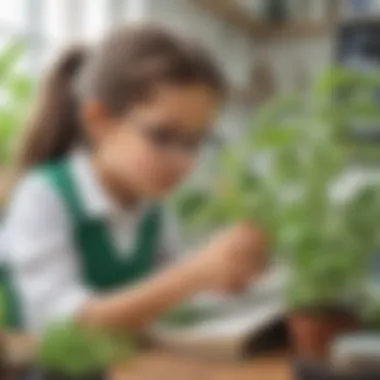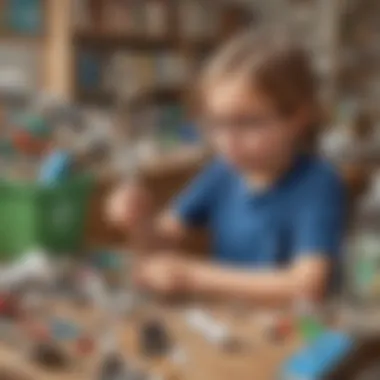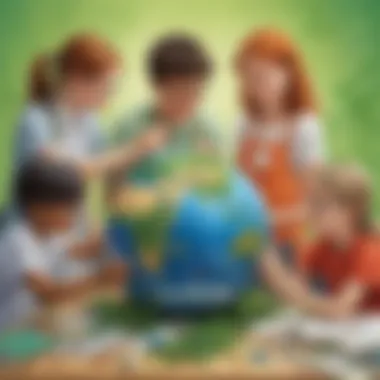Inspiring Earth Day Lessons for Young Science Enthusiasts: A Guide for Ages 6-12


Science Fun Facts
Discover the Wonders of Science
Exploring Various Scientific Concepts: Earth Day serves as a prime opportunity to introduce children to a myriad of scientific concepts related to the environment. From the water cycle and photosynthesis to ecosystems and climate change, young learners can delve into the intricate web of natural processes that sustain life on Earth. By nurturing a curiosity for the underlying principles governing our planet, children can develop a deeper appreciation for the interconnectedness of all living organisms and their habitats. Through engaging activities and hands-on experiments, youngsters can witness firsthand the wonders of science unfolding before their eyes, fostering a sense of wonder and appreciation for the natural world around them.
Educational Videos and Animations: In today's digital age, educational videos and animations offer a dynamic medium to convey complex scientific concepts in a visually engaging manner. From documentaries exploring the impact of human activities on the environment to animated shorts depicting the beauty of biodiversity, a wealth of online resources can captivate young minds and stimulate their interest in environmental science. By harnessing the power of multimedia storytelling, parents and educators can supplement traditional classroom learning with interactive visual aids that cater to diverse learning styles and preferences, enriching the educational experience for young science enthusiasts.
Interactive Learning Tools: Interactive learning tools, such as online simulations and virtual laboratories, provide an immersive platform for children to conduct virtual experiments and explore scientific phenomena in a safe and controlled environment. By offering interactive quizzes, virtual field trips, and hands-on demonstrations, these digital resources empower young learners to actively engage with scientific concepts, reinforcing their understanding through experiential learning. Through gamified activities that reward progress and incentivize exploration, interactive learning tools can transform passive spectators into active participants, fostering a sense of agency and curiosity in aspiring young scientists.
Real-Life Applications of Science: Bridging the gap between theoretical knowledge and practical application, real-life examples of scientific principles in action can deepen children's understanding of the relevance of science in their everyday lives. By showcasing inventions inspired by nature, such as Velcro and solar panels, young learners can appreciate the ingenuity of biomimicry and the potential of science to solve pressing environmental challenges. By highlighting the role of science in shaping sustainable technologies and innovative solutions, parents and educators can inspire young science enthusiasts to think critically and creatively about their role in advancing environmental conservation and promoting a more sustainable future for all.
Introduction
In the realm of environmental awareness and scientific curiosity, Earth Day stands as a pivotal moment of reflection and action. This annual event, celebrated worldwide on April 22nd, acts as a beacon of environmental consciousness and sustainability. In the context of this article dedicated to young science enthusiasts aged 6-12, Earth Day serves as a gateway to a multidimensional journey of exploration and learning. By delving into the nuances of this significant observance, children are bestowed with a profound opportunity to comprehend the intricate web of nature and the pressing need for ecological preservation.
The importance of the Introduction section within this comprehensive guide lies in setting the stage for a symbolic and educational pilgrimage into the heart of Earth Day. Through a meticulous exposition of the historical facets and contemporary significance of this occasion, young learners not only grasp the evolution of environmental advocacy but also internalize the urgency of sustainable practices. By unraveling the layers of Earth Day's roots and highlighting its exponential growth as a global movement, children are introduced to a realm of ethical responsibility and scientific inquiry. Fostering an early appreciation for the planet's delicate ecosystem, the Introduction nurtures a generation of eco-literate individuals poised to champion environmental stewardship.


Moreover, the Introduction segment of this article serves as a compass orienting young minds towards a path enriched with ecological insights and interactive engagement. By elucidating the overarching themes and educational objectives of Earth Day, children are invited to partake in a journey brimming with eco-friendly crafts, recycling projects, and nature walks. This foundation not only cultivates an environmental ethos but also instills a sense of wonder and curiosity regarding the intricate workings of the natural world. Through a judicious blend of information dissemination and hands-on activities, the Introduction section unfolds as a gateway to transformative learning experiences, igniting a passion for sustainability within budding scientists.
Understanding Earth Day
Earth Day is a significant event celebrated globally to raise awareness about environmental conservation and sustainability. In the context of this article, understanding Earth Day holds paramount importance as it serves as a foundation for introducing young science enthusiasts to the concept of ecosystem protection. By delving into the origins and principles of Earth Day, children aged 6-12 can grasp the urgency of preserving our planet for future generations. Exploring the history and evolution of Earth Day instills values of responsibility and stewardship towards nature, fostering a sense of belonging and interconnectedness with the environment they inhabit.
History of Earth Day
The history of Earth Day dates back to the early 1970s when concerns about pollution and environmental degradation began gaining traction. Senator Gaylord Nelson's initiative to create a day dedicated to environmental education and activism led to the first Earth Day on April 22, 1970. This landmark event mobilized millions of people worldwide, sparking a global movement advocating for cleaner air, water, and land. Understanding the history of Earth Day provides children with insights into the power of grassroots movements and collective action in addressing pressing ecological issues.
Importance of Earth Day
Earth Day holds immense significance in the current socio-environmental landscape, serving as a reminder of our interconnectedness with nature and the importance of sustainable practices. For young science enthusiasts, recognizing the importance of Earth Day instills a sense of environmental consciousness and empowers them to become advocates for positive change. By participating in Earth Day activities, children learn about biodiversity, conservation, and climate action, shaping their attitudes towards environmental stewardship. Emphasizing the importance of Earth Day cultivates a sense of environmental responsibility and encourages young minds to envision a greener, more sustainable future.
Educational Activities
Eco-Friendly Crafts


Eco-Friendly Crafts serve as a creative outlet that combines fun and environmental consciousness. Engaging children in crafting activities using recycled materials not only enhances their artistic skills but also educates them on the importance of upcycling and waste reduction. This hands-on approach allows kids to witness the transformation of everyday items into eco-friendly masterpieces, cultivating a sense of resourcefulness and environmental stewardship.
Recycling Projects
Recycling Projects are an integral part of Earth Day lessons as they demonstrate the impact of waste management on the environment. By engaging in recycling initiatives, children learn about the 3Rs (Reduce, Reuse, Recycle) and the importance of minimizing their ecological footprint. Participating in these projects empowers kids to make sustainable choices, equipping them with the knowledge to reduce waste and preserve natural resources for future generations.
Planting and Gardening
Planting and Gardening activities offer children a hands-on experience in understanding the lifecycle of plants and the significance of green spaces. Through planting seeds, nurturing seedlings, and observing plant growth, kids develop a deeper appreciation for nature's processes. Engaging in gardening not only teaches sustainability but also encourages healthy eating habits and a connection to the natural world.
Nature Walks and Exploration
Nature Walks and Exploration provide a direct immersion in the environment, allowing children to observe wildlife, vegetation, and ecological systems up close. These activities foster a sense of wonder and curiosity about the natural world, inspiring children to become environmental stewards. By exploring outdoor habitats, kids gain firsthand knowledge of biodiversity, ecosystems, and the importance of preserving natural spaces.
Interactive Experiments
Incorporating interactive experiments into the learning process allows children to witness firsthand the impact of human behavior on the environment. By immersing themselves in activities like water pollution simulations and composting demonstrations, young learners gain practical insights into how their actions can either harm or help the planet. These experiments serve as catalysts for critical thinking and problem-solving skills, empowering children to become environmentally conscious individuals in their communities.


Water Pollution Simulation Water pollution simulation activities provide an immersive experience for children to grasp the detrimental effects of pollution on aquatic environments. By replicating scenarios where pollutants are introduced into a controlled water source, young participants can observe the immediate consequences of such actions. This hands-on approach not only educates children about the importance of clean water sources but also instills a sense of responsibility towards preserving these vital resources.
Composting Demonstrations Composting demonstrations offer children a practical introduction to the concept of organic waste management and recycling. Through guided demonstrations, young learners can understand the natural processes involved in composting organic materials. By witnessing how food scraps and garden waste can be transformed into nutrient-rich soil, children develop a deeper appreciation for sustainable practices and the efficient use of resources. Composting demonstrations not only teach children about the benefits of recycling but also empower them to take active steps towards reducing waste and contributing to a greener future.
Quizzes and Challenges
Quizzes and Challenges play a vital role in engaging young science enthusiasts on Earth Day. These activities go beyond traditional learning methods, sparking curiosity and promoting critical thinking skills. By incorporating quizzes and challenges into Earth Day lessons, children are encouraged to actively participate and apply their knowledge in a fun and interactive manner. This section will delve into the significance of incorporating quizzes and challenges in educational activities aimed at fostering environmental awareness and sustainability.
Environmental Trivia Quiz
An Environmental Trivia Quiz offers an exciting opportunity for children to test their knowledge on various environmental topics. This quiz typically includes questions related to climate change, recycling, endangered species, and other key environmental issues. Through this engaging activity, young learners can broaden their understanding of the world around them while reinforcing important concepts about environmental conservation. Environmental trivia quizzes not only educate children but also motivate them to explore and research more about sustainability practices and ecosystem preservation.
Sustainability Puzzles
Sustainability Puzzles provide a creative and interactive way for children to learn about sustainable practices and green solutions. These puzzles often focus on matching eco-friendly actions with their positive environmental impacts or solving scenarios related to renewable energy and waste reduction. By solving sustainability puzzles, young science enthusiasts develop problem-solving skills and gain insight into the importance of making environmentally conscious decisions in their everyday lives. This section will explore the benefits of incorporating sustainability puzzles into Earth Day lessons, emphasizing their role in promoting eco-awareness and inspiring young minds to become stewards of the planet.
Conclusion
In dissecting the finer details, the Conclusion offers a platform for reflection and consolidation. It prompts young learners to connect the dots between the historical inception of Earth Day, the importance of environmental conservation, and the hands-on experience gained through engaging in eco-friendly crafts, recycling projects, planting, gardening, nature walks, interactive experiments, and quizzes. By encapsulating the essence of Earth Day and environmental stewardship, the Conclusion crystallizes the key takeaways for our eager young science enthusiasts.
Furthermore, the benefits of a well-crafted conclusion radiate beyond mere closure. It instills a sense of accomplishment and fulfillment in children, fostering a habit of reflection and synthesis of newfound knowledge. As young minds absorb information like sponges, providing a structured conclusion empowers them to organize their thoughts and insights effectively. This enhances cognitive skills such as critical thinking and analytical reasoning, laying a robust foundation for their intellectual growth.
Moreover, the Conclusion serves as a bridge that connects theoretical concepts with real-world applications. By prompting children to reflect on their Earth Day experiences and learnings, it cultivates a deeper sense of environmental consciousness and responsibility. This reflective practice nurtures empathy towards nature and instills a proactive attitude towards tackling environmental challenges, thereby shaping young minds into future stewards of our planet.
In essence, the Conclusion of this guide transcends mere closure; it symbolizes a beginning—a commencement of a journey towards environmental enlightenment and advocacy. By encouraging young science enthusiasts to ponder, synthesize, and contemplate their Earth Day lessons, the Conclusion plays a pivotal role in nurturing a generation of environmentally conscious and proactive individuals. It instills within young learners a sense of purpose and empowerment, equipping them with the knowledge and mindset needed to champion sustainability and environmental preservation in the years to come.







